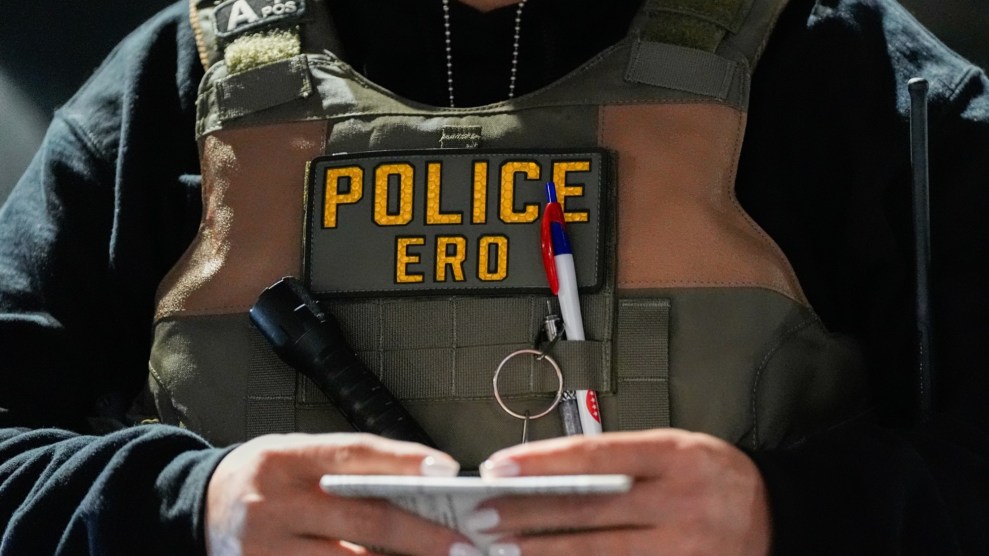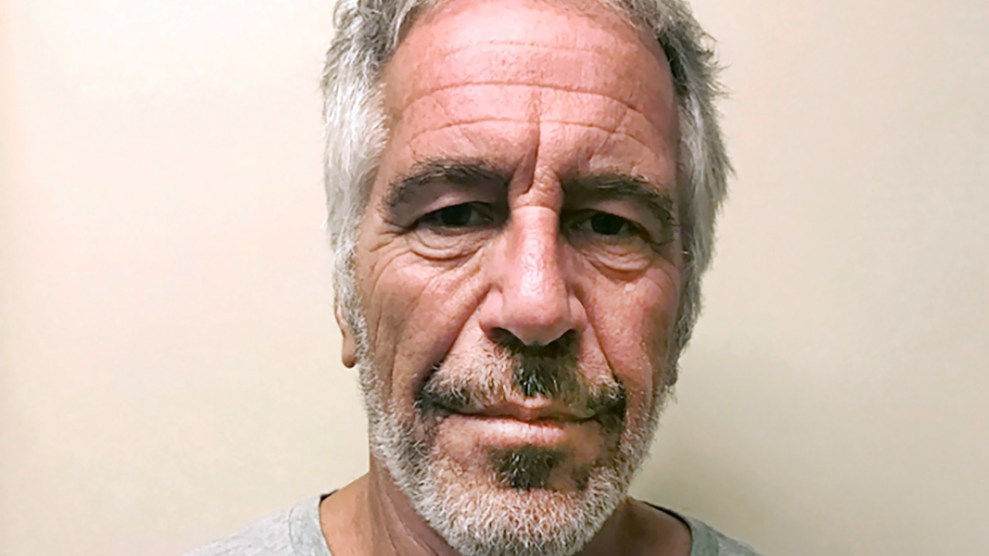
Julia Demaree Nikhinson/AP
President Donald Trump made a promise with his mass deportation plan: First, we’ll remove the “criminals.” In doing so, he framed his fear-fueled immigration enforcement overdrive as a purge for public safety. But the evidence—from reports on the ground, available data, and precedent—points to a different direction: immigration raids’ numbers boosted by the arrest of immigrants who haven’t committed crimes.
“There is no way for the Trump administration to achieve any of its enforcement goals without targeting immigrants with no criminal histories,” noted Austin Kocher, who researches immigration enforcement. And that’s exactly what is happening. NBC News and NPR recently reported that scores of immigrants without criminal histories have been arrested.
“Nobody’s showing me that there are more convicted criminals. Nobody’s showing me that there are more removable people coming into custody.”
From the beginning, the idea of deporting “millions and millions of criminal aliens” was deceiving. For starters, there aren’t that many deportable undocumented immigrants with criminal records in the country. (Immigrants are less likely to commit crimes than US citizens.) Of the 7.6 million immigrants on US Immigration and Customs Enforcement’s national docket for potential deportation, the agency reported that about 8 percent had a conviction or pending charges. The most common offenses? Traffic-related, according to ICE’s data.
To deliver on the campaign promise of the largest deportation operation in US history, the Trump administration has had to scale up the stats. On January 27, Trump called for a “massive increase” in immigration detention capacity and a “record investment” in interior enforcement, including deportation flights. “We’re getting them all out,” Trump said in a speech from his Doral, Florida, resort outside Miami. “I won on that.”
By them, Trump meant criminals being returned to Colombia. He said, “Every one of them [is] either a murderer or a drug lord, a kingpin of some kind, the head of the mob or a gang member.” But this was not true. As it turns out, the 200 or so immigrants flown on two planes back to the South American country last week had no criminal history, according to Colombian officials. “They’re not criminals,” former Foreign Minister Luis Gilberto Murillo said in a video statement. He added: “Being a migrant is not a crime.”
How has the White House squared this? By labeling all undocumented immigrants as criminals, even though unlawful presence in the country is a civil, not criminal, violation. When asked for the number of ICE arrests conducted so far that have specifically targeted immigrants with criminal records, press secretary Karoline Leavitt said, “all of them,” adding, “because they illegally broke our nation’s laws, and, therefore, they are criminals.”
STATS
— David J. Bier (@David_J_Bier) February 5, 2025
Biden: 295 arrests/day in FY25 (Oct-Nov)
-Trump: 626 arrests/day through Feb 3
Biden: 45 noncriminal arrests/day
-Trump: ~300 noncriminal arrests/day
Biden: 856 removals/day
-Trump: 407 removals/day https://t.co/rYYEXro7Sd
The truth is that the plan has always relied on a much more expansive approach. From day one, Trump took steps to advance a no-one’s-off-the-table immigration enforcement policy. He revoked a Biden-era mandate setting priorities for ICE and rescinded guidance limiting the agency’s activity in or near hospitals, places of worship, and schools. The Washington Post also reported that Trump officials are instructing ICE to ramp up arrests by setting a performance quota of 1,200 to 1,500 daily arrests. In an effort to meet that threshold, as many have observed, ICE officers will likely be incentivized to go after people of all backgrounds.
“They are arresting more people today than last year, I believe them when they say that,” Jason Houser, who served as chief of staff for ICE during the Biden presidency, told me recently. “But nobody’s showing me that there are more convicted criminals. Nobody’s showing me that there are more removable people coming into custody.”
The first Trump administration policies, the Cato Institute reported, often led to the release of immigrants charged with or convicted of crimes.
In the words of border czar Tom Homan, who served as acting director of ICE during Trump’s first term, as you open the “aperture,” more “collateral arrests” will follow. “When you release a public safety threat out of a sanctuary jail and won’t give us access to them,” Homan said on CNN, “that means we got to go to the neighborhood and find them…others that don’t have a criminal conviction but are in the country illegally, they will be arrested, too.”
These so-called “collateral arrests” are hardly an exception. The initial days of the second Trump administration have mimicked the first days of his first presidency, which also saw a high proportion of immigrants rounded up by ICE who had no criminal convictions or whose most serious offense was drunk driving.
Looking into immigration enforcement data, Kocher, the researcher, found that “immigrants without criminal histories tend to drive the overall numbers of arrests, detentions, and deportations.” After Trump took office in 2017 and until the pandemic hit, the number of ICE arrests of noncriminals went up, while those of immigrants with criminal convictions declined. The first Trump administration policies, the Cato Institute reported, often led to the release of immigrants charged with or convicted of crimes.
“More immigration enforcement,” Kocher concluded, “always means, as a rule, more people without criminal convictions getting arrested and detained.”
A case in point is a George W. Bush-era nationwide immigration enforcement program known as Secure Communities. Later expanded by the Obama administration, it allowed federal immigration authorities to check the immigration status of everyone arrested by local law enforcement through the automated sharing of fingerprints with the FBI and ICE. (Facing pressure from immigrant communities and advocates, as well as resistance from local authorities, the Obama administration ultimately replaced Secure Communities with a narrower enforcement initiative. In 2017, Trump revived the program.)
“It introduced on a wide scale for the first time in the United States this idea that just being arrested can now lead to deportation,” said Chloe N. East, an associate professor of economics at the University of Colorado Denver, who has researched the effects of Secure Communities. “What we saw in practice is that was not a perfect targeting mechanism.”
Almost half a million immigrants were deported under Secure Communities from 2008 to 2014. Although the initiative was intended to target threats to public safety, there is little evidence that it accomplished that goal. About 17 percent of the people deported as part of the program hadn’t been convicted of a crime. And for those with a criminal conviction, 79 percent had committed a nonviolent offense.
Researchers also found that deportations under Secure Communities had no significant impact on reducing crime rates or making communities safer. Instead, East explained, the rate of crimes being reported to law enforcement went down. “Once local law enforcement agencies start getting involved in immigration enforcement activity,” she said, “it creates a lot of distrust and fear among the immigrant community about interacting with law enforcement at all.”
Broad enforcement activity, East said, “necessitates that we’re going to end up detaining and deporting people who are not the intended targets.”


















